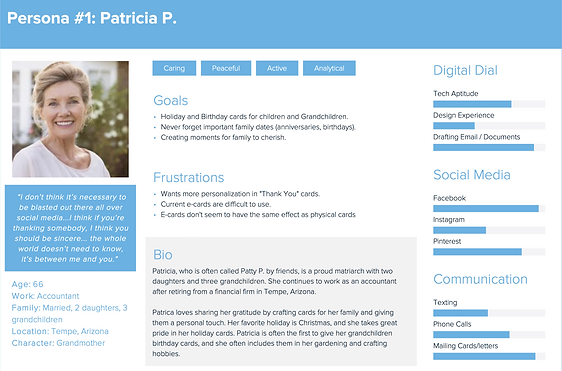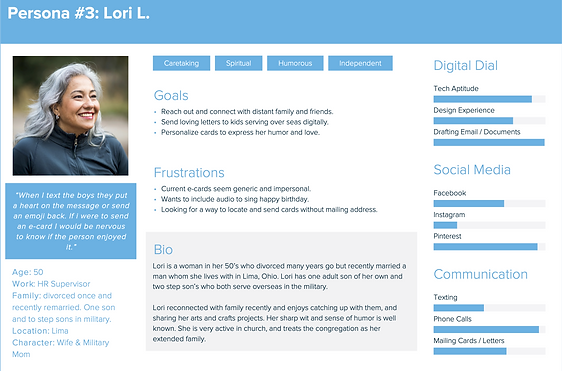Project Type
Semester-long project for SI 482: Interaction Design Studio
Challenge
Design an interactive prototype of a product for a target population that does not consist of only college students. This product must also focus on allowing users to express, share or deliver their gratitude.
My Roles
- UX Researcher
- UX Designer
Timeframe
4 months
Key Takeaways
When designing a product from scratch, it is very important to conduct research at every point in the process. I learned that conducting a good deal of research in the beginning stages of product ideation and product design will result in a much better product for users.
Process
Jump to:
Team
Ben Kozlowski, Courtney Fortin, Catherine Grillo, Nick Sidor, Michelle Xie
Problem Statement
Creating e-cards can be difficult for older populations. This inspired my team to create an accessible and user-friendly way to show gratitude for the people in your life. E-cards can feel inauthentic, so this app aims to allow users to create and send meaningful messages to friends and family.
E-Care does this through an accessible user experience that allows for customization and relevant distribution. E-Care shares gratitude with the feeling of a handmade card in the digital age.
Competitive Analysis
After coming up with our idea for an e-card application, the first step in our process was to conduct a competitive analysis. We looked at two direct competitors and an analogous competitor.
User Interviews
Next, the entire team conducted user interviews with middle-aged/older populations to see what issues the generation has with connecting online and what they might like to see in e-cards. Below is the analysis from the interviews I conducted with a 66 and a 68-year-old woman.
Three themes stood out to me while interviewing my participants:
-
The main form of social media use is Facebook
-
There is a desire for more personal ways to reach out digitally
-
Gratitude is more appreciated in a private context, rather than in a public post on social media
Personas & Scenarios
While designing the personas and scenarios, we wanted to make sure to cover a wide range of users based on the information from my team's user interviews.

Scenario
Patricia is interested in sending an e-card to her grandchildren because she hasn’t been able to connect with them lately on the phone due to their busy schedules. She wants to send them something that might be more special than a text. She searches options to create e-cards and chooses the first link that appears in the search results without looking at the other options. She wants to tell her grandchildren that she is thinking about them and hopes to see them or talk to them soon.
Patricia browses the template options for the cards but notices that most cards are for birthdays, graduation, congratulatory, or a different theme. After a good amount of scrolling, she finds the more general cards and selects one. She is frustrated that there aren't a lot of personalization options available but eventually completes a design she likes. Patricia emails the e-cards to her grandchildren, but worries they wont open the e-card because they aren’t checking their email too much. She wishes there was a more meaningful way to reach out.

Scenario
Stanley was playing golf one day when a friend of his mentioned how he had recently been using e-card websites to send e-cards to relatives for their birthdays. Stanley remembers that his grandchildren have been asking if he could communicate digitally more because they think digital communication is easier. Even though he does not have a lot of experience with technology and feels a bit intimidated, he decides to give e-cards a try.
Stanley’s grandson’s birthday is coming up. He decides to try out the e-card website his friend recommended to send an e-card to his grandson. But when he gets on the e-card website, he immediately has trouble reading the text on the website because it’s small and is in a fancy font. He squints at the page and picks out a card option that looks nice, but the instructions for how to customize and send out the card are not clear to him. Stanley is frustrated but also does not ask anyone else for help because he doesn’t like asking other people for help. He decides to not use the e-card website and decides to mail his grandson a birthday card instead.

Scenario
Lori misses her two stepsons who are currently stationed overseas. She figures sending physical cards is difficult because of overseas shipping and not having a definite way to locate her stepsons. Being tech savvy, she decides to send an e-card to them instead. Lori has a design background and is thinking about creating her own design, but after she realizes you can’t easily design the card using some kind of editor, she decides to go with a pre-made appreciation template.
Lori wants her kids to know how much she misses them and is thinking about a story when she was amused by them and their antics. She looks if there’s a way to record a voice message on the card but does not find one. Disappointed, she polishes up the card, only later seeing a place where she can include a voice message with the card. Lori’s curious how the voice message will look on the card, but decides to try it anyway. After finalizing her creation, she previews the card, only to see the voice message does not appear on the card. She practices sending a card to herself, and realizes her recording will be attached to the email. Lori feels a bit disappointed because she wants everything on the card, but decides to send the card anyway. She sends the cards, feeling glad it’s finished, but also a bit fatigued over her difficulties with the process.
User Flow
Creating a user flow helped my team plan out how the application will work and aided in our process while building the prototypes.
.png)
Click image to expand
Paper Prototype
Each person on our team made a paper prototype outlining a certain process a user might go through. My paper prototype, shown in the video below, portrays a user that wants to create a card by using the search feature on our app.
Interactive Prototype
After the paper prototype, it was time to create the interactive prototype in Figma. I, along with my teammates, built out the pages of the app and created the necessary interactions.
Roadblocks
Timeline
Throughout the semester, I felt that I was being rushed through the process which was a bit overwhelming. Each week was a new step to learn and execute. This presented a learning curve, but I was able to figure out the timing and thrive in the fast-paced and demanding environment.
Working Synchronously
One of my teammates was living in London for the duration of the project, which created problems when trying to schedule meetings. I suggested we all sit down and either fill out a when2meet poll or discuss regular meeting times in class. We eventually all were able to meet and discuss times that would be appropriate for us, accommodating each other and allowing us to work synchronously instead of asynchronously.


